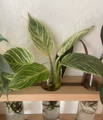The Philodendron Birkin has been one of our favorite plants to grow in water. We've grown them in our regular MOBO frames and in larger vases as well. They have incredible multi-colored green and white stripped leaves, some of the plants have incredible variegation on them.
This plant isn't a super fast grower like some of the Pothos and other philodendrons, however it will consistently continue to shoot off new leaves. The roots are pretty fun to watch develop as well as they can have unique colors.
Native to the Caribbean as well as Central & South America
Araceae
Philodendron White Wave, Birkin White wave, Hermés Birkin handbag plant, Philodendron Burkin.
Some popular types of philodendren are Philodendron Brandi, Philodendron Brasil, Philodendron Hope Selloum, Philodendron Lemon Lime, Philodendron Little Hope, Philodendron Prince of Orange, Philodendron Shangri La, Philodendron Velvet, and Philodendron Xanadu.
Toxic to pets and humans if consumed.

For healthy plants, we recommend that you add water to the glass every 1-2 weeks (or if you see that water levels have lowered) to replenish the water that evaporated or absorbed from the plants. Then, replace the water every 2-4 weeks.
Most tap water works great but distilled or filtered waters are recommended if available.
We recommend adding 1-2 of liquid nutrients to your philodendron's water every month. To further encourage and support leaf growth, we recommend adding an additional drop of nutrients if you see a new leaf forming.
Philodendrons love bright indirect light! They prefer areas in the home like a brightly lit corner or across a window that receives a lot of sunlight.
For philodendron Birkin, the ideal temperature range is 65-78 degrees Fahrenheit. A general rule of thumb for many tropical houseplants is that if you are comfortable, then they will be comfortable too!
Philodendrons prefer moderate to high humidity, but can do well in most home settings regardless of humidity level. We recommend that you spritz them with water every now and again to give it a bit of humidity.
Philodendron's easily propagate in water through most of the year. To do so, take a cutting with one or more leaves and a node or two. Submerge the node in a cup with filtered water and find a bright, warm space with indirect light for the plant. Roots generally form in 2 to 3 weeks.
Identification: brown holes in the leaves, browning tips that are crispy to the touch
Cause: Overexposure to sunlight
How to treat:Simply move your plant away from any direct sunlight or places with too much sunlight. Try placing your philodendron in a nearby area with less light exposure or somewhere where it won't have any contact with the sun. You can remove any brown tips if you like, but it's not necessary to your plant's recovery.
Identification: color patterns in the leaves are fading, leaves becoming a solid green color
Cause: When your philodendron is creating solid green leaves, this means that your plant is not receiving enough bright indirect light.
How to treat: Move your plant to an area where it would be exposed to more bright indirect light and wait for the leaves to recover their color. For newer leaves, they will gain their markings as they age.
Identification: leaves are curling at the ends or dropping, leaves also may turn yellow or brown
Cause: There are multiple causes for this issue. One, the air in your environment is too dry. Two, your plant is not receiving enough oxygen from the water. And three, your plant is experiencing extremely cold temperatures.
How to treat: To fix this issue, move your plant away from any AC vents, heaters, or open windows. Also, mist regularly if your environment is usually very dry. If the cause is a lack of oxygen, simply replace the water for the plant and then continue on a 2 week to monthly water replacement schedule.